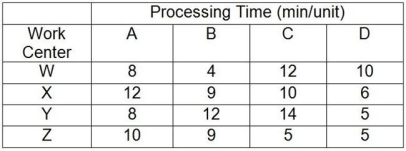Multiple Choice
Table 5.2
A company makes four products that have the following characteristics: Product A sells for $75 but needs $20 of materials and $20 of labor to produce; Product B sells for $90 but needs $45 of materials and $20 of labor to produce; Product C sells for $110 but needs $50 of materials and $30 of labor to produce; Product D sells for $135 but needs $75 of materials and $40 of labor to produce. The processing requirements for each product on each of the four machines are shown in the table.

Work centers W, X, Y, and Z are available for 40 hours per week and have no setup time when switching between products. Market demand is 50 As, 60 Bs, 70 Cs, and 80 Ds per week. In the questions that follow, the traditional method refers to maximizing the contribution margin per unit for each product, and the bottleneck method refers to maximizing the contribution margin per minute at the bottleneck for each product.
-Use the information in Table 5.2. Using the bottleneck method, in what sequence should products be scheduled for production?
A) A, D, B, C
B) D, A, B, C
C) A, D, C, B
D) D, A, C, B
Correct Answer:

Verified
Correct Answer:
Verified
Q9: Any factor that limits the performance of
Q10: Describe three ways that line balancing and
Q11: Schmidt Industries makes four different snake traps;
Q12: Table 5.4<br>The Superior Management Company assembles muffalettas
Q13: The process batch at the constraint in
Q15: You have been assigned a line balancing
Q16: Use the process flow diagram to determine
Q17: Line balancing applies only to line processes
Q18: A competent operations manager should first eliminate
Q19: Line balancing is the assignment of work